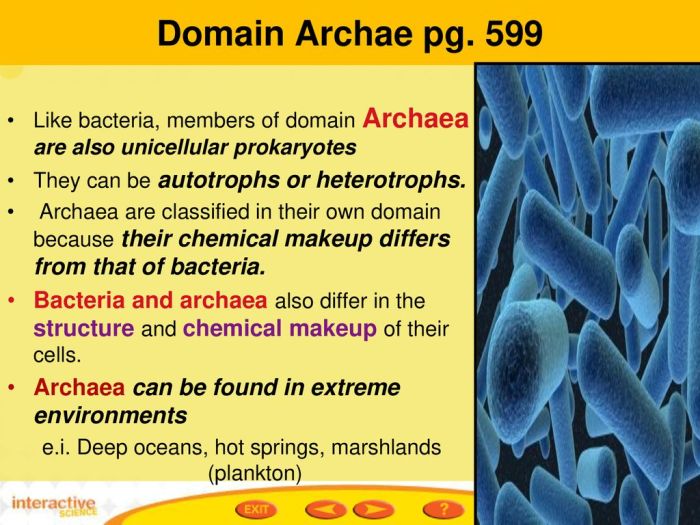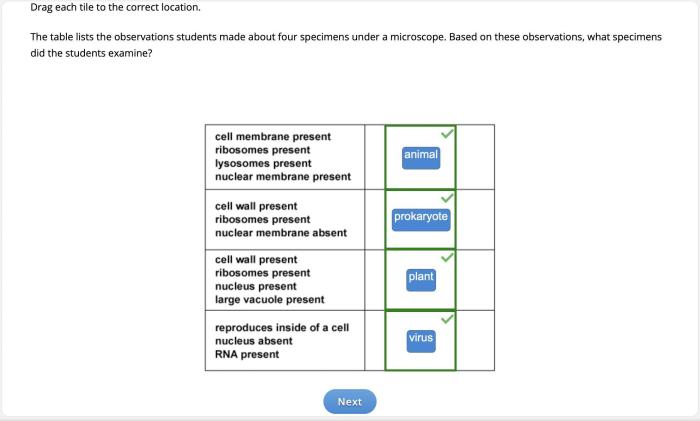Embarking on an exploration of archaea’s nutritional strategies, we delve into the captivating realm of is archaea a heterotroph or autotroph. This enigmatic group of microorganisms exhibits remarkable diversity in their modes of sustenance, blurring the boundaries between the traditional classifications of heterotrophs and autotrophs.
Prepare to unravel the intricate metabolic pathways and ecological roles of these fascinating organisms as we embark on this journey of scientific discovery.
Within the vast tapestry of life, archaea occupy a unique position, challenging our understanding of microbial diversity. Their distinct cellular machinery and ancient evolutionary lineage set them apart from bacteria and eukaryotes, prompting scientists to establish a separate domain for their classification.
As we delve into the nutritional modes of archaea, we uncover a spectrum of strategies that defy conventional categorizations, showcasing the remarkable adaptability and resilience of these microorganisms.
Classification of Archaea: Is Archaea A Heterotroph Or Autotroph

Archaea, formerly classified as archaebacteria, are a distinct domain of single-celled microorganisms. They are prokaryotes, meaning they lack a nucleus or other membrane-bound organelles, but they possess unique characteristics that distinguish them from bacteria and eukaryotes.
Key Characteristics
- Cell Wall:Archaea have a unique cell wall structure composed of pseudopeptidoglycan, which differs from the peptidoglycan found in bacteria.
- Lipid Membranes:Archaeal cell membranes contain ether-linked lipids instead of ester-linked lipids, making them more resistant to extreme environments.
- RNA Polymerase:The RNA polymerase of archaea is more similar to that of eukaryotes than to that of bacteria.
- Metabolism:Archaea exhibit a diverse range of metabolic capabilities, including methanogenesis, sulfur reduction, and ammonia oxidation.
Nutritional Modes in Archaea

Archaea exhibit a diverse array of nutritional strategies, ranging from autotrophy to heterotrophy. This metabolic versatility allows them to thrive in a wide range of environments, including extreme habitats such as hydrothermal vents, deep-sea sediments, and hypersaline lakes.
Autotrophic Metabolism
Autotrophic archaea are capable of synthesizing their own organic compounds from inorganic molecules using energy derived from light or chemical reactions. They play a crucial role in the global carbon cycle and are the primary producers in many extreme environments.
- Photoautotrophs:Use light energy to convert carbon dioxide into organic compounds through photosynthesis. Examples include Halobacteriumand Sulfolobus.
- Chemoautotrophs:Utilize chemical energy from inorganic compounds, such as sulfur or hydrogen sulfide, to synthesize organic molecules. Examples include Methanobacteriumand Acidianus.
Heterotrophic Metabolism
Heterotrophic archaea obtain their organic compounds from other organisms or organic matter. They play a significant role in nutrient cycling and decomposition in various ecosystems.
- Saprobes:Decompose dead organic matter, releasing nutrients back into the environment. Examples include Methanosarcinaand Haloarcula.
- Parasites:Live on or within other organisms, obtaining nutrients from their host. Examples include Nanoarchaeum equitansand Ignicoccus hospitalis.
- Symbionts:Engage in mutually beneficial relationships with other organisms, exchanging nutrients and protection. Examples include Methanococcus jannaschiiand Archaeoglobus fulgidus.
Autotrophic Archaea
Autotrophic archaea are a diverse group of microorganisms that can synthesize their own food from inorganic compounds. They play a vital role in the cycling of carbon and nitrogen in the environment and are found in a wide variety of habitats, including extreme environments such as hot springs and deep-sea hydrothermal vents.
Metabolic Pathways
Autotrophic archaea use a variety of metabolic pathways to fix carbon dioxide into organic compounds. The most common pathway is the Calvin cycle, which is also used by plants and cyanobacteria. Other pathways include the reductive acetyl-CoA pathway and the Wood-Ljungdahl pathway.
Role in Primary Production
Autotrophic archaea are important primary producers in many ecosystems. They are responsible for fixing carbon dioxide into organic compounds that can be used by other organisms. In some ecosystems, such as the deep sea, archaea are the primary source of fixed carbon.
Extremophilic Archaea
Some archaea are extremophiles that can thrive in extreme environments. These archaea include methanogens, which produce methane as a byproduct of their metabolism, and halophiles, which can tolerate high salt concentrations. Extremophilic archaea play an important role in the cycling of nutrients in extreme environments.
Heterotrophic Archaea
Heterotrophic archaea obtain their organic compounds from other organisms, either as saprophytes or parasites.
Mechanisms of Heterotrophic Nutrition
Saprophytic archaea decompose organic matter, releasing nutrients back into the environment. They secrete enzymes that break down complex organic compounds into simpler molecules, which they can then absorb. Parasitic archaea obtain their nutrients from living hosts, often causing harm to the host organism.
Diversity of Substrates Utilized
Heterotrophic archaea utilize a wide range of substrates, including carbohydrates, proteins, lipids, and even some inorganic compounds. Some species are highly specialized, while others are more generalist in their nutritional requirements.
Ecological Roles, Is archaea a heterotroph or autotroph
Heterotrophic archaea play important roles in nutrient cycling and decomposition. They break down organic matter, releasing nutrients that can be utilized by other organisms. They also contribute to the formation of methane and other greenhouse gases, which have implications for the global climate.
Symbiotic Relationships Involving Archaea

Archaea engage in diverse symbiotic relationships with other organisms, forming mutually beneficial or commensalistic associations. These symbiotic interactions can provide various advantages to both parties involved.
Benefits and Costs of Symbiotic Associations
Symbiotic relationships between archaea and other organisms can confer numerous benefits. Archaea can provide essential nutrients, such as vitamins, amino acids, and energy sources, to their symbiotic partners. In return, archaea may gain access to oxygen, protection from predators, or a stable environment.
However, symbiotic relationships can also carry costs. Archaea may compete with their symbiotic partners for resources or produce harmful byproducts that can affect the host’s health.
Examples of Symbiotic Archaea in Different Ecosystems
Archaea form symbiotic relationships in various ecosystems. In hydrothermal vents, archaea engage in mutualistic associations with tube worms and mussels, providing them with essential nutrients and energy. In the human gut, methanogenic archaea form a commensalistic relationship with humans, producing methane as a byproduct of their metabolism.
In anaerobic environments, such as swamps and marshes, methanogenic archaea cooperate with bacteria to break down organic matter, producing methane as a byproduct.
Comparative Analysis of Autotrophic and Heterotrophic Archaea

Autotrophic and heterotrophic archaea exhibit distinct characteristics, metabolic pathways, and ecological roles. Autotrophic archaea, like plants, utilize inorganic compounds (e.g., carbon dioxide) as their primary carbon source, converting them into organic matter through photosynthesis or chemosynthesis. In contrast, heterotrophic archaea rely on organic compounds (e.g.,
glucose) for energy and carbon, resembling animals in their nutritional mode.
Key Characteristics
- Carbon Source:Autotrophs use inorganic carbon, while heterotrophs use organic carbon.
- Energy Source:Autotrophs use light (photosynthesis) or inorganic compounds (chemosynthesis), while heterotrophs use organic compounds.
- Metabolic Pathways:Autotrophs have specialized pathways for carbon fixation, such as the Calvin cycle or reductive acetyl-CoA pathway. Heterotrophs employ glycolysis, the TCA cycle, and oxidative phosphorylation.
Metabolic Pathways
- Autotrophs:Utilize the Calvin cycle (photosynthesis) or reductive acetyl-CoA pathway (chemosynthesis) to fix carbon dioxide.
- Heterotrophs:Employ glycolysis, the TCA cycle, and oxidative phosphorylation to break down organic compounds for energy.
Ecological Roles, Is archaea a heterotroph or autotroph
- Autotrophs:Primary producers in many ecosystems, providing the foundation for food webs.
- Heterotrophs:Decomposers and nutrient recyclers, breaking down organic matter and releasing nutrients back into the environment.
Helpful Answers
What is the significance of archaea in carbon fixation?
Archaea play a crucial role in carbon fixation, particularly in extreme environments where other organisms struggle to survive. They utilize diverse metabolic pathways, including methanogenesis and acetogenesis, to convert inorganic carbon into organic compounds, contributing significantly to the global carbon cycle.
How do heterotrophic archaea contribute to nutrient cycling?
Heterotrophic archaea are essential decomposers in various ecosystems, breaking down complex organic matter into simpler compounds. They participate in nutrient cycling by releasing nitrogen, phosphorus, and other elements back into the environment, making them available for other organisms.
What are some examples of symbiotic relationships involving archaea?
Archaea engage in diverse symbiotic relationships, including mutualism, commensalism, and parasitism. Methanogenic archaea, for instance, form symbiotic associations with certain animals, such as termites and ruminants, aiding in the digestion of cellulose. Other archaea establish symbiotic relationships with hydrothermal vent organisms, contributing to their survival in extreme environments.